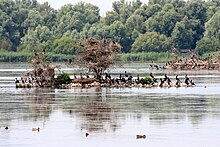
Environment of the Netherlands
The Netherlands had a 2018 Forest Landscape Integrity Index mean score of 0.6/10, ranking it 169th globally out of 172 countries. [1]

Environment of the Netherlands
The Netherlands had a 2018 Forest Landscape Integrity Index mean score of 0.6/10, ranking it 169th globally out of 172 countries. [1]
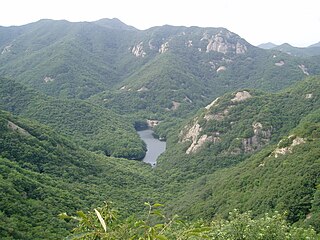
The environment of South Korea is the natural environment of South Korea, which occupies the southern half of the Korean peninsula. Environment - current issues: air pollution in large cities; water pollution from the discharge of sewage and industrial effluents; acid rain; drift net fishing.

Environmental issues in Mali include desertification, deforestation, soil erosion, drought, and inadequate supplies of potable water. Deforestation is an especially serious and growing problem. According to the Ministry of the Environment, Mali’s population consumes 6 million tons of wood per year for timber and fuel. To meet this demand, 4,000 square kilometers of tree cover are lost annually, virtually ensuring destruction of the country’s savanna woodlands.
Like other countries in the Soviet sphere of influence, Bulgaria strongly emphasized heavy industry and intensive agriculture but did not mitigate the environmental consequences of such a policy. As a result, in the early 1990s an estimated 60 percent of agricultural land was polluted by fertilizers and pesticides, two-thirds of rivers were polluted, and two-thirds of primary forests had been leveled.
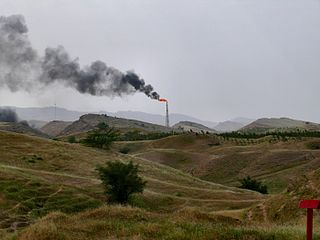
Environmental issues in Iran include, especially in urban areas, vehicle emissions, refinery operations, and industrial effluents which contribute to poor air quality. A report by the United Nations Environment Programme ranked Iran at 117th place among 133 countries in terms of environmental indexes. Water scarcity is a serious issue, and the country is also threatened by climate change.

Environmental issues in Nepal include a number of issues, such as deforestation, climate change, energy and species conservation. Many of these issues have been precipitated by rapid industrialization without major environmental regulation.

Turkey hosts more than three thousand endemic plant species, has high diversity of other taxa, and is almost entirely covered by three of the world's thirty-five biodiversity hotspots. Although some environmental pressures have been decoupled from economic growth the environment still faces many threats, such as coal and diesel fuel emitting greenhouse gases and deadly fine particulate air pollution. As of 2023 there is no fine particulate limit and coal in Turkey is subsidized. Some say the country is a pollution haven.
Like most former republics of the Soviet Union, Azerbaijan experienced rapid economic development which has led to an increasingly negative impact on the environment, including the inefficient usage of natural resources. The government of Azerbaijan has aimed to increase environmental protection and ensure rational utilization of natural resources, and has introduced a number of important laws, legal documents and state programs in order to improve the ecological situation in the country. However, these precautionary laws have not been as effective as they were meant to be. Transparency has been a consistent issue in Azerbaijan, as NGOs who are given legal authority to collect data from the oil refineries are often blocked or dismissed, and their information is gathered unofficially. Domestic oil producers have often evaded the regulations, and have not prevented oil leaks into the Caspian Sea. In the next 30 years, Azerbaijan will produce more oil than it produced during the 20th century, and currently there is little coordination or environmental precaution in the oil drilling operations. There is also a lack of communication with neighboring countries bordering the Caspian Sea.
Urban, city, or town planning is the discipline of planning which explores several aspects of the built and social environments of municipalities and communities:
James J. Kay was an ecological scientist and policy-maker. He was a respected physicist best known for his theoretical work on complexity and thermodynamics.

The environment of Côte d'Ivoire has more than 1,200 animal species—223 mammal, 702 bird, 125 reptile, 38 amphibian, and 111 fish species—and 4,700 plant species. It is the most biodiverse country in West Africa, but unlike other countries there, its diversity isn't concentrated along the coast, but rather in the rugged interior. However, much like the rest of West Africa, Côte d'Ivoire has suffered severe deforestation.

The environment of Trinidad and Tobago reflects the interaction between its biotic diversity, high population density, and industrialised economy.

Malaysia faces several environmental issues. Malaysia's environment possesses megadiverse biological diversity, with globally significant endemism and biodiversity, but is threatened by several issues. Deforestation is a major issue in the country that has led to many species becoming threatened with extinction. As a major economic sector, palm oil production has had a substantial environmental impact. Air pollution is also a major issue, with the country one of the most affected countries by seasonal Southeast Asian haze. The country is also affected by climate change.
The Environment of Ecuador contains almost 20,000 species of plants, 1,500 species of birds, 341 species of mammals and more than 840 species of reptiles and amphibians. It includes World Heritage Sites like the Galápagos Islands, and magnificent parks such as the Yasuni National Park.
Cuba possesses a diverse range of natural habitats, housing a wide variety of species, including many endangered ones. However, the country has faced environmental challenges, particularly deforestation, since the arrival of European settlers. Forest areas have been cleared for agricultural purposes, leading to the loss of forests and the extinction of certain species. The cutting down of trees for fuel and construction materials has further contributed to this issue.
There are a number of known environmental issues in the post-communist country of Albania. Issues include air and water pollution, poor waste management infrastructure and deforestation. The Albanian environmental movement includes around 40 active non-government organisations.

Environmental issues in Singapore include air, water pollution, and deforestation. The government established the Singapore Green Plan in 1992 to help with environmental issues.

The environment of North Korea comprises the diverse ecosystems of the part of the Korean peninsula controlled by the Democratic People's Republic of Korea. This includes alpine, forest, farmland, freshwater, and marine ecosystems.

There are many pressing environmental issues in Mongolia that are detrimental to both human and environmental wellness. These problems have arisen in part due to natural factors, but increasingly because of human actions. One of these issues is climate change, which will be responsible for an increase in desertification, natural disasters, and land degradation. Another is deforestation, which is expanding due to human recklessness, pests, disease, and fires. Mongolian lands are becoming more arid through desertification, a process that is being exacerbated due to irresponsible land use. Additionally, more and more species are disappearing and at risk for extinction. Moreover, especially in population centers, Mongolians deal with air and water pollution caused by industrialization.
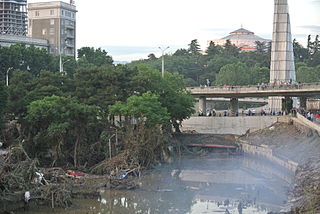
Situated in the South Caucasus Region bordered by the Black Sea to the West, the Russian Federation to the North, Azerbaijan to the East, Turkey to the Southwest, and Armenia to the South, Georgia is a small country supplied with profitable natural resources, heavenly scenes, copious water assets, rich living spaces, and ecosystems that are of local and worldwide significance.
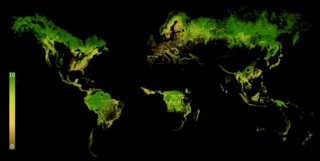
The Forest Landscape Integrity Index (FLII) is an annual global index of forest condition measured by degree of anthropogenic modification. Created by a team of 48 scientists, the FLII, in its measurement of 300m pixels of forest across the globe, finds that ~17.4 million km2 of forest has high landscape-level integrity, compared to ~14.6 million with medium integrity (6–9.6) and ~12.2 million km2 with low integrity (0–6).